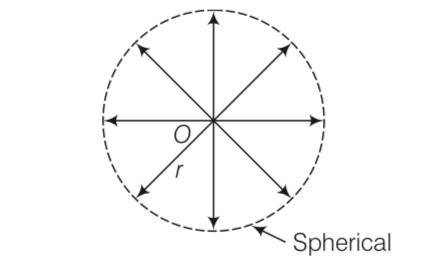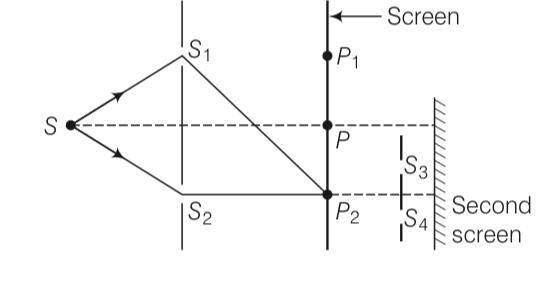Physics Ncert Solutions Class 12th
Get insights from 1.2k questions on Physics Ncert Solutions Class 12th, answered by students, alumni, and experts. You may also ask and answer any question you like about Physics Ncert Solutions Class 12th
Follow Ask QuestionQuestions
Discussions
Active Users
Followers
New answer posted
4 months agoContributor-Level 10
This is a Multiple Choice Questions as classified in NCERT Exemplar
Answer- (a, b)
Explanation- Due to the point source light propagates in all directions symmetrically and hence, wavefront will be spherical as shown in the diagram.

If power of the source is P, then intensity of the source will be I= p/4 2
where, r is radius of the wavefront at anytime.
New answer posted
4 months agoContributor-Level 10
This is a Multiple Choice Questions as classified in NCERT Exemplar
Answer- (a, b)
Explanation- (a) When a decreases w increases. So, size decreases.
(b) Now, light energy is distributed over a small area and intensity?1/Area is decreasing so intensity increases
New answer posted
4 months agoContributor-Level 10
This is a Multiple Choice Questions as classified in NCERT Exemplar
Answer – (b, d)
Explanation- We know that wavelength of sunlight ranges from 4000 Å to 8000 Å.
Clearly, wavelength λ < width of the slit.
Hence, light is diffracted from the hole. Due to diffraction from the slight the image formed On the screen will be different from the geometrical image.
New answer posted
4 months agoContributor-Level 10
This is a short answer type question as classified in NCERT Exemplar
An inductor opposes flow of current through it by developing a back emf according to Lenz's law. The induced voltage has a polarity so as to maintain the current at its present value. If the current is decreasing, the polarity of the induced emf will be so as to increase the current and vice -versa.
Since, the induced emf is proportional to the rate of change of current, it will provide greater reactance to the flow of current if the rate of change is faster, i.e., if the frequency is higher. The reactance of an inductor, therefore, is proportional to the frequency. Mat
New answer posted
4 months agoContributor-Level 10
This is a Multiple Choice Questions as classified in NCERT Exemplar
Answer- (a, b, d)
Explanation-Consider the pattern of the intensity shown in the figure
(i) As intensities of all successive minima is zero, hence we can say that two sources S1 and S2 are having same intensities.
(ii) As width of the successive maxima (pulses) increases in continuous manner, we can say that the path difference (x) or phase difference varies in continuous manner.
(iii) We are using monochromatic light in YDSE to avoid overlapping and to have very clear pattern on the screen.
New answer posted
4 months agoContributor-Level 10
This is a short answer type question as classified in NCERT Exemplar
A capacitor does not allow flow of direct current through it as the resistance across the gap is infinite. When an alternating voltage is applied across the capacitor plates, the plates are alternately charged and discharged. The current through the capacitor is a result of this changing voltage (or charge).
Thus, a capacitor will pass more current through it if the voltage is changing at a faster rate, i.e. if the frequency of supply is higher. This implies that the reactance offered by a capacitor is less with increasing frequency.
Mathematically, the reactance can be
New answer posted
4 months agoContributor-Level 10
This is a Multiple Choice Questions as classified in NCERT Exemplar
Answer- d
Explanation- According to question, there is a hole at point P2. From Huygen's principle, wave will propagates from the sources S1 and S2. Each point on the screen will acts as secondary sources of wavelets. Now, there is a hole at point P2 (minima). The hole will act as a source of fresh light for the slits S3 and S4.
Therefore, there will be a regular two slit pattern on the second screen
New answer posted
4 months agoContributor-Level 10
This is a short answer type question as classified in NCERT Exemplar
Ps=60W, Is= 0.54 A
P=VI, V= 60/0.54= 110V
Voltage in the secondary is less than voltage in primary so transformer is step down transformer
As transformation ratio is, k = Es/Ep= Ip/Is
110/220=Ip/0.54A
Ip= 0.27A
New answer posted
4 months agoContributor-Level 10
This is a Multiple Choice Questions as classified in NCERT Exemplar
Answer – (c)
Explanation- For the interference pattern to be formed on the screen, the sources should be coherent and emits lights of same frequency and wavelength. In a Young's double-slit experiment, when one of the holes is covered by a red filter and another by a blue filter. In this case due to filteration only red and blue lights are present. In YDSE monochromatic light is used for the formation of fringes on the screen. Hence, in this case there shall be no interference fringes.
New answer posted
4 months agoContributor-Level 10
This is a short answer type question as classified in NCERT Exemplar
L= 0.01H
R= 1ohm
Voltage =200V
Frequency = 50Hz
Z= = = =3.3ohm
tan = = 3.14
= tan-13.14=72
=72
= /w= = s
Taking an Exam? Selecting a College?
Get authentic answers from experts, students and alumni that you won't find anywhere else
Sign Up on ShikshaOn Shiksha, get access to
- 65k Colleges
- 1.2k Exams
- 686k Reviews
- 1800k Answers


